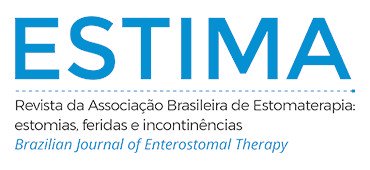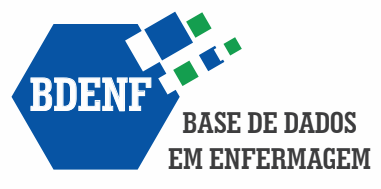STRATEGIES FOR THE PREVENTION OF FACIAL PRESSURE INJURIES CAUSED BY THE USE OF THE PRONE POSITION
Abstract
Objective: Identify the main strategies for preventing facial pressure injuries caused by the use of the prone position. Methods: Integrative literature review, carried out during the month of March 2021. Articles were searched in the MEDLINE, LILACS, BDENF and IBECS databases. The selected articles were written in English, Portuguese and Spanish, between 2016 and 2021. Duplicates and those that did not include the topic addressed were excluded. Initially, 29 articles were identified. After applying the inclusion and exclusion criteria, 10 articles resulted for analysis. Results: Of the complications related to the use of the prone position, 10 (100%) of the studies address the pressure injury as the main complication of this therapeutic maneuver. As for prevention strategies, the studies analyzed cite the change in position associated with the use of pads and hydrocolloids as the main preventive methods. Conclusion: The following strategies to prevent facial pressure injury by using the prone position were identified: change of decubitus at pre-established times; use of devices that provide relief from pressure points, such as pads and hydrocolloids; and the use of low-cost and easily accessible materials, such as adapted surgical sponges, respecting the anatomical structures of each patient.
Downloads
Metrics
References
Benjamin MF, Santos AC, Salvador AC, Jorge MA. Posição prona em unidade de terapia intensiva. Revista UNILUS Ensino e Pesquisa. 2018 [citado 2021 Mar 28];15(40):77-83. Dispon vel em: http://revista.lusiada.br/index.php/ruep/article/view/977/u2018v15n40e977
Busnardo FF, Monteiro GM, Mendes RR, Abbas L, Pagotto VF, Camargo C et al. A multidisciplinary approach to prevent and treat pressure sores in proned COVID-19 patients at a quaternary university hospital. Clinics. 2020;75:e2196. https://doi.org/10.6061/clinics/2020/e2196
Shearer SC, Parsa KM, Newark A, Peesay T, Walsh AR, Fernandez S et al. Facial pressure injuries from prone positioning in the COVID-19 era. Laryngoscope. 2020;131(7):E2139-E2142. https://doi.org/10.1002/lary.29374
National Pressure Ulcer Advisory Panel (US); European Pressure Ulcer Advisory Panel; Pan Pacific Pressure Injury Alliance. Prevention and treatment of pressure ulcers: quick reference guide. Haesler E, editor. Australia: Cambridge Media; 2014. 72 p. Disponível em: http://medi-guide.meditool.cn/ymtpdf/7D604C9A-DC46-5665-E57B-EB4BEF621213.pdf
Vasconcelos JM, Caliri MH. Ações de enfermagem antes e após um protocolo de prevenção de lesões por pressão em terapia intensiva. Esc Anna Nery. 2017 [cited 2021 Mar 27]; 21(1):e20170001. https://doi.org/10.5935/1414-8145.20170001
Sousa MM, Neiva MJLM, Silva MFN, Vieira JL, Melo MF, Reis EM et al. Cuidados de enfermagem na prevenção às lesões por pressão em pacientes hospitalizados. Braz J Hea Rev 2019;2(5):4336-44. https://doi.org/10.34117/bjhrv2n5-036
Olkoski E, Assis GM. Aplicação de medidas de prevenção para úlceras por pressão pela equipe de enfermagem antes e após uma campanha educativa. Esc Anna Nery. 2016;20(2)363-9. https://doi.org/10.5935/1414-8145.20160050
Mendes KS, Silveira RC, Galv o CM. Revisão integrativa: método de pesquisa para a incorporação de evidências na saúde e na enfermagem. Texto Contexto − Enferm. 2008; 17(4):758-64 apud Sousa LM, Marques-Vieira CM, Severino SS, Antunes AV. A metodologia de revisão integrativa da literatura em enfermagem. RIE. 2017[citado 2021 Mar 29];21(2):20. Disponível em: http://www.sinaisvitais.pt/images/stories/Rie/RIE21.pdf#page=17
Melnyk BM, Fineout-Overholt E. Evidence-based practice in nursing and healthcare: a guide to best practice. Philadelphia (PA): Lippincott Williams & Wilkins; 2005. p.3-24.
Moher D, Liberati A, Tetzlaff J, Altman DG, Prisma Group. Preferred reporting items for systematic reviews and meta-analyses: the PRISMA statement. PLoS Med. 2009;6(7): e1000097. https://doi.org/10.1371/journal.pmed.1000097
Martel T, Orgill DP. Medical Device–Related Pressure Injuries During the COVID-19 Pandemic. J Wound Ostomy Continence Nurs. 2020;47(5):430-4. https://doi.org/10.1097/WON.0000000000000689
Ramondetta A, Ribero S, Costi S, Dapavo P. Pression-induced facial ulcers by prone position for COVID-19 mechanical ventilation. Dermatologic Therapy. 2020;33(4):e13748. https://doi.org/10.1111/dth.13748
Daniel LB, Gabriel VGR, Flávio MDA, Rapello GVG, Andrade FMD. Posição prona no tratamento da insuficiência respiratória aguda na Covid-19. ASSOBRAFIR [Internet] 2020. [cited 2021 Mar 16]. Available from: https://assobrafirciencia.org/article/ doi/10.47066/2177-9333.AC20.covid19.011
Souza MFC. Risco de lesão por pressão em UTI: adaptação transcultural e confiabilidade da EVARUCI. Acta Paul Enferm. 2018;31(2):201-8. https://doi.org/10.1590/1982-0194201800029
Alhazzani W, M ller MH, Arabi YM, Loeb M, Gong MN, Fan E et al. Surviving Sepsis Campaign: guidelines on the management of critically ill adults with Coronavirus Disease 2019 (COVID-19). Intensive Care Med. 2020;46(5):854-87. https://doi.org/10.1007/s00134-020-06022-5
Oliveira VM, Piekala DM, Deponti GN, Batista DCR, Minossi SD, Chisté M et al. Checklist da prona segura: construção e implementação de uma ferramenta para realização da manobra de prona. Rev Bras Ter Intensiva. 2017;29(2):131-41.
https://doi.org/10.5935/0103-507X.20170023
Ponseti EJ, Mill n AV, Chinchilla DO. Análisis de las complicaciones del decúbito prono en el sindrome de distrés respiratório agudo: estándar de calidad, incidencia y factores relacionados. Enferm Intensiva. 2017;28(3):125–34. https://doi.org/10.1016/j.enfi.2016.12.003
Lucchini A, Bambi S, Mattiussi E, Elli S, Villa L, Bondi H et al. Prone position in acute respiratory distress syndrome patients: a retrospective analysis of complications. Dimens Crit Care Nurs. 2020;39(1):39-46. https://doi.org/10.1097/DCC.0000000000000393
Moore Z, Patton D, Avsar P, McEvoy NL, Curley G, Budri A et al. Prevention of pressure ulcers among individuals cared for in the prone position: lessons for the COVID-19 emergency. J Wound Care. 2020;29(6):312-20. https://doi.org/10.12968/jowc.2020.29.6.312
Stubington TJ, Mansuri MS. Novel technique using surgical scrub sponges to protect the nose and face during prone ventilation for coronavirus disease 2019. J Laryngol Otol. 2020; 134(8):735–8. https://doi.org/10.1017/S0022215120001590
Weller DI, Batista DCR, Moretti MMS, Piekala DM, Oliveira VM, Carleti M. Perfil clínico e complicações em pacientes pronados: uma coorte de um hospital universitário. Clin Biomed Res. 2019;39(4):301-6. https://doi.org/10.22491/2357-9730.96420
Perrillat A, Foletti J-M, Lacagne A-S, Guyot L, Graillon N. Facial pressure ulcers in COVID-19 patients undergoing prone positioning: How to prevent an underestimated epidemic? J Stomatol Oral Maxillofac Surg. 2020;121(4):442–4. https://doi.org/10.1016/j.jormas.2020.06.008
Kim RS, Mullins K. Preventing Facial Pressure Ulcers in Acute Respiratory Distress Syndrome (ARDS). J Wound OstomyContinence Nurs. 2016;43(4):427-9. https://doi.org/10.1097/WON.0000000000000247
Downloads
Published
Versions
- 2021-08-18 (2)
- 2021-08-18 (1)
How to Cite
Issue
Section
License
Copyright (c) 2021 Larissa de Lima Machado Bandeira, Sarah Maria Osório de Carvalho, Layane Raquel Ribeiro Calaça, Geysa Maria dos Santos Rabelo, Wesley Caio Ferreira Barbosa, Bruno Abílio da Silva Machado, Josiane Santos Silva

This work is licensed under a Creative Commons Attribution 4.0 International License.

























